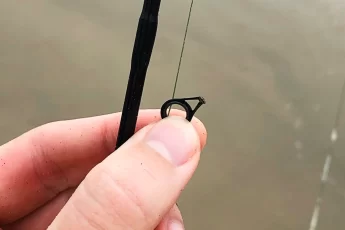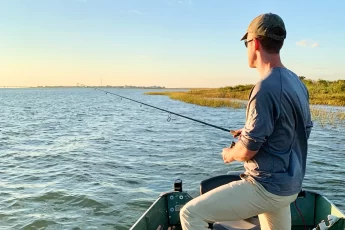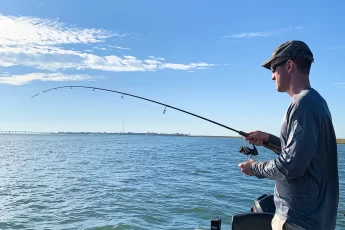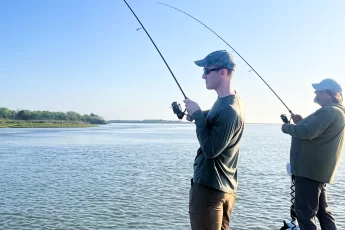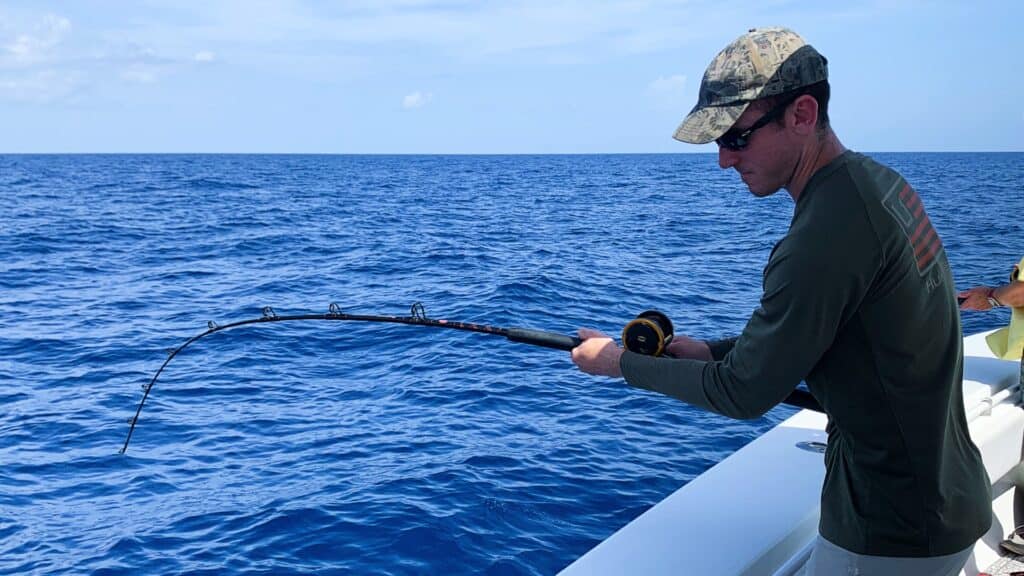
Updated 2/13/2024
Saltwater fishing covers a huge array of techniques from wading to deep sea trolling. Shopping for such diverse strategies can put a huge strain on the fishing budget because anglers may think they need dozens of expensive rods to maximize chances of success. Fortunately, some of the best saltwater fishing rods are at an affordable price point below $100 without sacrificing effectiveness, meaning anglers of any budget can get out on the water catching fish.
I’ve done the hours of rod research and testing on weight, strength, durability, and material quality so you don’t have to. Check out my top recommendations for the best saltwater rods under $100 to have the right rods for the job.
*Disclosure: I only recommend products I would use myself and all opinions expressed here are my own. This post may contain affiliate links that at no additional cost to you, I may earn a small commission.
Our Top Picks
We’ve tailored a list of the top saltwater rods under $100 for different saltwater fishing techniques. Check out our top choices!
- Best Saltwater Rod for the Money Under $100: Ugly Stik Bigwater Rod
- Best Offshore Rod Under $100: Penn Rampage Boat Conventional Rod
- Best Surf Spinning Under $100: Fiblink Surf Spinning Fishing Rod
- Best Surf Conventional Under $100: Penn Squadron III Surf Conventional Rod
- Best Saltwater Trolling Rod Under $100: Fiblink Trolling Rod with Ring Guides
The 5 Best Saltwater Rods Under $100
Whether you’re a novice angler or a grizzled expert, we have you covered. Check out my recommendations for overall best saltwater rods under $100 for categories like best for the money, offshore, surf, and more! You don’t need to take out a second mortgage to afford decent quality fishing gear.
1. Ugly Stik Bigwater Rod
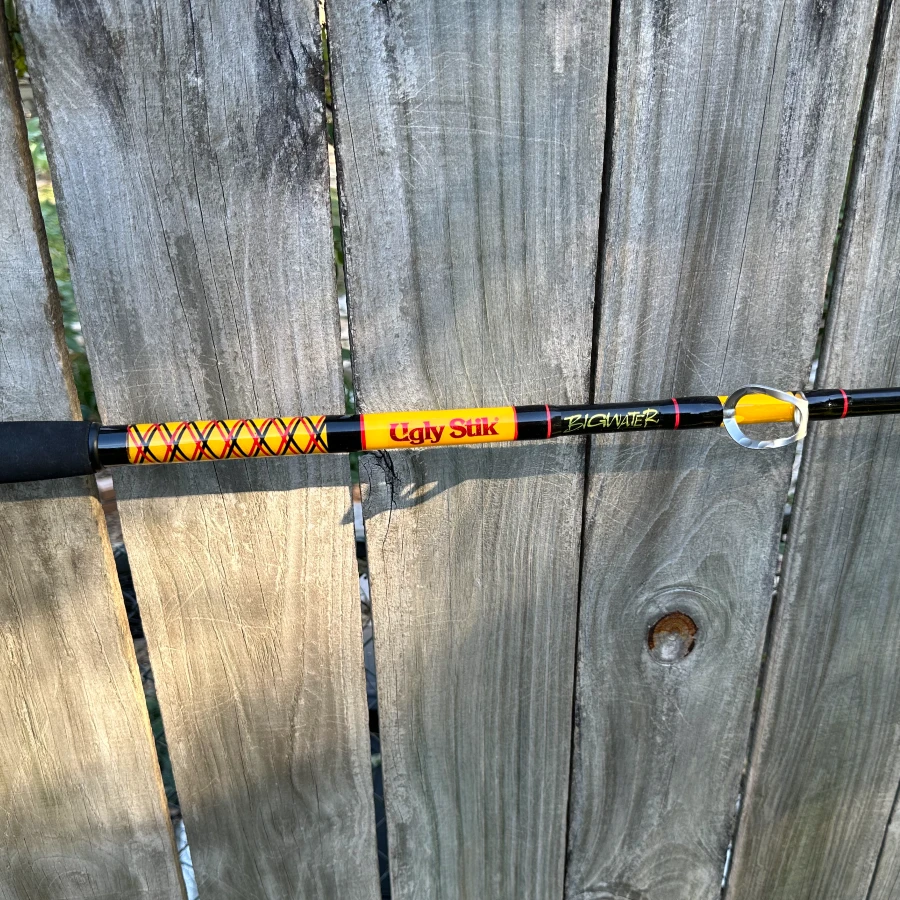
- Length: 6’6″ to 15′
- Power: Medium to Heavy
- Rod Material: Ugly Tech (combo graphite & fiberglass)
- Guides: Stainless Steel
- Handle: EVA Foam
- Warranty: 7 Year manufacturing only
Pros:
- Budget friendly
- Wide size range makes it a great budget option as a shorter inshore rod or longer surf rod
Our choice for the best saltwater fishing rod under $100 for the money is the Ugly Stik Bigwater Fishing Rod. Budget pricing doesn’t mean budget performance. This rod is nearly indestructible and comes in a range of sizes and powers perfect for nearly all types of saltwater fishing.
This rod is plenty sturdy. It’s heavier and less sensitive than most other similar class rods. The stainless steel inserts will succumb to saltwater corrosion quicker than pricier alternatives. The foam handle is functional and feels fine (although we personally prefer cork!).
We love that this rod comes in a huge range of sizes and it has a better warranty than many of the pricier rods available. This is a great saltwater option for both inshore or surf fishing. For inshore, get one around 7′. For surf fishing we recommend 10-12′.
This is an excellent budget option that can catch fish just as well as higher-end rods. Don’t think twice about adding an Ugly Stik Bigwater to your fishing arsenal.
Check out our article on the best saltwater fishing rods for other great options at higher price points in case you’re looking to upgrade!
2. Penn Rampage Boat Conventional Rod
- Length: 6′ to 7’6″
- Power: Medium-Heavy to Heavy
- Rod Material: Fiberglass
- Grip: EVA Foam
- Guides: Stainless Steel Frames with Aluminum Oxide Inserts
- Warranty: 1 Year manufacturing defects only
Pros:
- Budget friendly
- Super Strong
Our choice for the best offshore saltwater fishing rod under $100 is the Penn Rampage Conventional Boat Rod. We like the Penn Rampage because it is a no-frills, super sturdy, workhorse rod that can handle the demands of fighting huge fish offshore.
The rod blank is extremely strong, albeit heavy, tubular fiberglass which is perfect for offshore fishing. The reel seat is graphite whereas many higher-end offshore rods may have a stronger aluminum reel seat. It has a rubber gimbal on select models to reduce the worries of scratching up your boat gunnel while fighting a massive offshore fish.
The Penn Rampage is a great offshore saltwater rod under $100.
3. Fiblink Surf Spinning Rod
- Length: 10 – 15 feet
- Rod Material: Carbon Fiber
- Grip: EVA Foam
- Guides: Stainless Steel w/ceramic inserts
- Warranty: 1 Year
Pros:
- Budget friendly
Surf fishing doesn’t need to break the bank! The Fiblink Surf Spinning Rod is our choice for the best saltwater surf fishing rod under $100 and is a great option for the budget conscious angler. You don’t need expensive gear to catch fish!
Like many budget fishing pole options, this rod is heavier and less sensitive than more expensive rods. That said, you could purchase four Fiblink Surf rods for the same price as a higher end surf rod!
We recommend thoroughly rinsing the guides with freshwater after any outing to prolong the life of the stainless steel.
We were pleasantly surprised that even a budget rod includes a warranty period (albeit 1 year). It’s better than nothing, but the 3 or 5 year warranty periods of the mid to high tier surf rod lines are notably better.
The Fiblink is a great entry point saltwater surf fishing rod for an affordable price well under $100. Check out our article on the best surf fishing rods for upgrade options!
4. Penn Squadron III Surf Conventional Fishing Rod
- Length: 10 – 12 feet
- Rod Material: Graphite Composite
- Grip: EVA Foam
- Guides: Stainless steel
- Warranty: 1 Year manufacturing defects only
Pros:
- Budget friendly conventional rod
Our choice for the best conventional surf casting rod under $100 is the Penn Squadron III Surf Conventional Rod. This rod is a great choice for anglers that prefer surf fishing with conventional reels. The Squadron III is budget friendly, sturdy, and comes the ten to twelve foot size selection is perfect for surf fishing applications.
Conventional setups are popular for surf fishing because of the comparatively large line capacity and ease of casting. For surf anglers targeting huge fish like massive sharks or bull reds, think about getting a conventional setup if only for the ability to fit plenty of large diameter line on the reel. We think the 12′ Penn Squadron III Surf rod in heavy power is a great budget friendly option for surf anglers wanting to target massive fish.
For great conventional reels to pair with conventional surf rods, check out our article on the best conventional reels.
5. Fiblink Trolling Rod with Ring Guides
- Length: 6′ to 7’6″
- Rod Material: Blend of fiberglass & carbon
- Guides: Stainless Steel Ring Guides
- Grip: EVA Foam
- Warranty: 1 Year Manufacturing Defects
Pros:
- Great price point for saltwater trolling rod
Our choice for best saltwater trolling rod under $100 is the Fiblink Trolling Rod with Ring Guides. This is a heavy power trolling option focusing on larger fish featuring a 30-50 lb line rating on the smaller version and a massive 80-120 lb line rating on the heaviest version.
The Fiblink Trolling Rod is a great option for trolling anglers looking for a sturdy rod at a reasonable price point. This is the version with ring guides whereas some anglers prefer roller guides for heavy trolling. It has a sturdy aluminum alloy wheel seat for a robust connection between the reel and the rod.
Check out our article on the best trolling rods for great upgrade options.
Best Saltwater Rods Under $100 Comparison Table
Check out this handy table comparing some of the key features of the rods on our list.
| Rod Name | Length | Rod Material | Guides | Grip | Warranty |
|---|---|---|---|---|---|
| Ugly Stik Bigwater Rod | 6’6″ to 15′ | Ugly Tech (combo graphite & fiberglass) | Stainless Steel | EVA Foam | 7 Year manufacturing only |
| Penn Rampage Boat Conventional Rod | 6′ to 7’6″ | Fiberglass | Stainless Steel Frames with Aluminum Oxide Inserts | EVA Foam | 1 Year manufacturing defects only |
| Fiblink Surf Spinning Rod | 10 – 15 feet | Carbon Fiber | Stainless Steel w/ceramic inserts | EVA Foam | 1 Year |
| Penn Squadron III Surf Conventional Fishing Rod | 10 – 12 feet | Graphite Composite | Stainless steel | EVA Foam | 1 Year manufacturing defects only |
| Fiblink Trolling Rod with Ring Guides | 6′ to 7’6″ | Blend of fiberglass & carbon | Stainless Steel Ring Guides | EVA Foam | 1 Year Manufacturing Defects |
Conclusion
The best saltwater rods under $100 may not have high-end features but there are many solidly constructed, reliable rod options out there. We really like the Ugly Stik Bigwater Fishing Rod as our overall favorite choice because it comes in a great spread of lengths and powers while being a reliable rod choice to catch saltwater fish.
What are you waiting for? Get out there and catch some fish!
Check out our articles for great reels to pair with these rods:
- Best Saltwater Reels
- Best Saltwater Baitcasting Reels
- Best Inshore Reels
- Best Saltwater Spinning Reels
- Best Reels for Redfish and Speckled Trout
- Best Flounder Reels
- Best Conventional Reels
- Best Trolling Reels
Check out our related rod articles:
- Best Beginner Fishing Rods
- Best Saltwater Fishing Rods
- Best Saltwater Rod & Reel Combos
- Best Rods for Redfish and Speckled Trout
- Best Flounder Rods
- Best Sheepshead Rods
- Best Surf Fishing Rods
- Best Surf Fishing Rod & Reel Combos
- Best Pier Fishing Rods
- Best Trolling Rods
How to Choose The Best Saltwater Rod Under $100 For You
Choosing the best saltwater rod under $100 should account for factors like rod power, action, materials, and portability. Additionally, anglers should consider what fishing technique they intend to use the rod for.
For even more reading, check out our article on how to choose any fishing rod.
Length
Saltwater anglers should pick rod length based on what type of fish they are after and what kind of fishing they intend to do. Generally, longer rods can cast further, and shorter rods are easier to maneuver and are sturdier. Saltwater anglers inshore fishing should pick a rod around 7 feet long. This is a great length to be able to cast relatively far but still have the accuracy to pinpoint cast to a specific spot. For surf fishing, longer rods allow for greater casting distance so something between 10 and 12 feet is a great option. Offshore boat fishing generally doesn’t require long casting distances so rods between 6’6″ and 7’6″ work well.
Power
Rod power is the fishing industry’s terminology for rod stiffness. Rod powers range from ultralight to heavy. Medium power is a great all around choice for saltwater fishing.
Saltwater species are generally larger and stronger fighters than many freshwater species, so we recommend rods from medium to heavy for saltwater. If targeting huge species like bull reds or sharks, size up to a heavy rod. If targeting reds, speckled trout, or striped bass sized fish, medium power is perfect.
Action
Rod action refers to how far down the rod will bend when pressure is applied to the tip. Rod actions range from extra-fast (bends near tip) to slow (nearly the whole rod bends).

The faster the action, the more sensitive the rod will feel. The slower the action, the more casting distance you can get (the rod will feel like it whips more when you cast).
Saltwater rods with moderate to fast actions are ideal. They provide a balance of accurate casting and sensitivity. Fast or extra-fast tips are great for working topwater baits. Moderate actions are better for working crankbaits. Fast actions are great all-around options. Check out our article on fishing rod actions for even more information.
Portability
Another key factor to picking the best inshore fishing rod is portability.
Seven foot long rods fit in most vehicles and boat rod holders. Much longer and you may run into problems. Make sure you check if your rod can fit in your vehicle before you make a purchase!
Think about purchasing multi-piece ‘travel’ versions of rods and/or look into travel cases to help protect your rod during transport. There’s nothing worse than accidentally breaking a guide or the rod tip on the way to the boat launch or beach.
Handle Material
Rod handle feel is an important factor to consider when picking an inshore fishing rod. Common handle types are rubber shrink tube, cork tape, or neoprene. Rubber shrink is usually considered a more budget option, whereas cork or neoprene feels better to grip and handle.
Rod Guide Material
Rod guide material is important because lower quality materials are heavier and will rust quicker and could potentially fail. This can be partially avoided by rinsing rod guides with freshwater after every trip.
The highest end rods have titanium or silicone carbide (SiC) rod guides whereas middle end or budget rods will have some variation of aluminum oxide or stainless steel.
Higher end rod guides are made with lighter materials with lower friction that will either rust slower or not at all. Less expensive rod guides are heavier and will succumb to the elements more quickly.
For additional information on rod guide considerations, check out our article that explains fishing rod guides in detail.
Rod Material
Rod blank material affects rod strength and how the fishing rod deforms during casting or reeling in a fish. Common rod materials are graphite, fiberglass, and composite. Check out our deep dive on rod blanks for more information.
Graphite
Graphite rods have incredible sensitivity in lightweight packages. They are great for detecting subtle fish strikes. Graphite rod disadvantages are that the rods can be a little weaker than the other options and more susceptible to breakage, especially around nicks or scratches.
Fiberglass
Fiberglass is strong, durable and flexible but weighs more than graphite. They are less sensitive than the other types of rod materials.
Composite
Composite rod materials are a mix of graphite and fiberglass that seek to have the light weight and sensitivity of graphite rods with the strength of fiberglass rods.
Reel Seat
Reel seats are the component where the fishing reel is secured onto the fishing rod by tightening a locking nut. The basic parts of a reel seat are the body, hood, locking nut, and barrel threads. Common reel seat materials are either graphite or aluminum which are both lightweight, corrosion resistant materials. Reel seats are sized to match the power of the rod. For example, a reel seat on an ultralight fishing rod won’t fit a massive 10000 size spinning reel.
Most freshwater applications utilize fully graphite reel seats due to graphite’s light weight. For heavier duty saltwater applications, reel seats are commonly upgraded to machine-grade aluminum for increased strength. For targeting the largest fish on the planet, the complete rod butt and reel seat can be aluminum for maximum strength.
Maintenance and Care
Maintaining your fishing rod ensures its longevity and performance. After each use, rinse it with fresh water to remove dirt and debris, especially if you’ve been fishing in saltwater. Dry it thoroughly before storage to prevent rust and corrosion. Occasionally check for any signs of wear or damage. Store your rod vertically or horizontally on a rack, avoiding extreme temperatures or direct sunlight.
Explore our ultimate guide on fishing rod maintenance and care for comprehensive insights into maintaining your saltwater fishing rod, avoiding common causes of damage, and mastering preventative strategies to ensure your gear remains in prime condition.
Saltwater Fishing Rod Frequently Asked Questions
What type of rod is best for saltwater fishing?
The best all around rod for inshore saltwater fishing is a 7 foot, medium power rod. This rod is a perfect mix of strength and sensitivity to catch most saltwater fish species. If surf fishing, choose a longer rod that is between 10 and 12 feet long. For offshore fishing for larger fish species, up-size to a heavy power rod.
What reel to pair with saltwater rod?
Saltwater rods should be paired with saltwater rated reels. Saltwater reels are built with corrosion resistant parts and hold up much better to the salty conditions. A 4000 size spinning reel is a great all around choice for common species like redfish, speckled trout, flounder, and striped bass. Size up to 8000 or larger for offshore or surf fishing for species like bull reds, sharks, and grouper.
Check out our articles on the best surf fishing reels, best saltwater casting reels, and the best saltwater spinning reels which would be great to pair with these saltwater rods.
Be sure to thoroughly clean your equipment after surf fishing with a gentle freshwater rinse. Sand and salt spray gets in everything and your gear will last longer if you spray it down after each outing.
What is the best length saltwater fishing rod?
The best all around rod length for saltwater fishing is 7 feet long. This length rod can accurately make long casts while still having enough backbone to reel in larger saltwater species.
How many yards of line do you need for a saltwater rod?
Preferably 200 yards or more. You want plenty of line to make long casts. Also, large fish may pull a bunch of line if they make a run for it. Swapping from mono to braid can help with this because braid has a smaller diameter meaning you can fit more on the reel spool.
Is mono or braid better for saltwater fishing?
Braided fishing line is preferable for saltwater fishing. Braided line has significantly smaller diameter for the same strength line when compared to mono. This can be key while surf fishing, because wind and waves will constantly be pulling at your line. The smaller diameter means less effect from the elements.
What kind of bait for saltwater fishing?
Saltwater fishing can be done with both live and artificial baits. A common type of surf fishing is using live bait on a bottom rig like a fish finder rig or high low rig (check out our in-depth article on the best surf fishing rigs). Rig up a 1/2 – 4 oz weight and live bait on a circle hook and you’ll be catching fish in no time. You can catch anything from bull reds to sharks surf fishing with live bait. Common surf fishing baits are live shrimp, cut bait, squid, and crab (check out our article on the best surf fishing baits).
Artificial lures like soft plastic baits on jig heads or shrimp under a popping cork as also popular.

Written By: Andrew Juran
Andrew is a seasoned angler with over 25 years of experience fishing across the United States. He has caught hundreds of saltwater fish using various techniques and mentored many in the art of fishing. An advocate for sustainable fishing, Andrew is an active member of the Coastal Conservation Association, an organization committed to marine conservation.
For frequent fishing tips, behind-the-scenes looks, and real-time catches, connect with Andrew on Instagram







